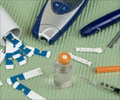A sensor technology that could significantly simplify the diagnosis and monitoring of diabetes has been developed by scientists.

The Pitt team was interested in this biomarker as a possible diagnostic tool.
"Once patients are diagnosed with diabetes, they have to monitor their condition for the rest of their lives," said Alexander Star, principal investigator of the project and Pitt associate professor of chemistry.
"Current monitoring devices are mostly based on blood glucose analysis, so the development of alternative devices that are noninvasive, inexpensive, and provide easy-to-use breath analysis could completely change the paradigm of self-monitoring diabetes," he noted.
Together with his colleagues-Dan Sorescu, a research physicist at the National Energy Technology Laboratory, and Mengning Ding, a Pitt graduate student studying chemistry-Star used what's called a "sol-gel approach," a method for using small molecules (often on a nanoscale level) to produce solid materials.
The team combined titanium dioxide-an inorganic compound widely used in body-care products such as makeup-with carbon nanotubes, which acted as "skewers" to hold the particles together. These nanotubes were used because they are stronger than steel and smaller than any element of silicon-based electronics.
Advertisement
The researchers found the sensor could be activated with light to produce an electrical charge. This prompted them to "cook" the "skewers" in the sensor under ultraviolet light to measure acetone vapors-which they found were lower than previously reported sensitivities.
Advertisement
The team is currently working on a prototype of the sensor, with plans to test it on human breath samples soon.
Their findings were published in the latest issue of the Journal of the American Chemical Society (JACS).
Source-ANI









